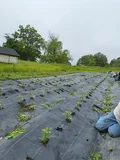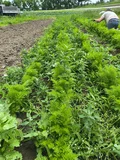TL;DR
I harvested and weeded a lot today. I also discussed value-added product strategy with a farmer. This was where I hoped I would be last year, but it took some hard work to get here. And it will take more to see any of it through.
Scoped Experimentation
No experiment can be learned from without at least some initial boundary conditions, constraints, or expectations. In one of my prior corporate roles, I took on the challenge/experiment of trying to create a legitimate space for experimentation. I was lucky to have a sharp, pragmatic and caring boss and direct reports. Through the years of the pandemic, we did the best we could to provide air cover and opportunity to those who were creative and bold enough to try something without fear of failure or judgement.
Scoping is vital to experimentation in two ways:
- Proper scope ensures that there is sufficient, presumably appropriate constraints to drive outcomes
- Aligned scope helps communication about the value of experiments (and experimentation) to decision makers
Not appropriately defining boundaries around experiments can lead to a lack of focus and resources, potentially resulting in wasted effort and missed opportunities. Positive outcomes are not the only value of experiments since you can often learn just as much from a failed experiment than a successful one. But the only things that look like work worth funding (from corporate leadership, investors, etc.) are positive business outcomes, not negative ones. (At a later time, I’ll research what this bias in formally trained management is called.)
My career experiment failed and succeeded in various ways. Many ideas were turned into features or new products (‘new product initiatives’, a.k.a. NPIs). The people involved (except for me and my boss) are still employed there in various roles. The processes hardened in this crucible are still used to this day. Many others who experienced the impact have since moved on, hopefully and meaningfully influenced by the work we did.
Tacit Approval
There are times for formal approval. Many of my conversations with very well tenured academic and industrial leaders help me understand this within the context of military, high-risk, mission critical contexts. “ATO”…Authority to Operate…is a term used in many DoD uses of specific tech stacks, on submarine installations where ‘production environment’ means life or death.
There are so many more…civilian…times where approval takes on other forms. In the corporate experimentation scenarios, most of my experience relied on implicit and short-term risk factors. Some were self-imposed rigor and others took the form of one-on-ones and midnight prep sessions for the next day of C-level big room meetings.
Today my ‘tacit approval’ came in the form of very polite and short conversation with the farmer about next steps to confirm research direction while weeding tomatoes. In short, rather than waiting a season/year to plan out ‘big’ co-packing relationships, I suggested that we experiment with a few small batch value-added products to validate the demand by local consumers. This supports the initiative for a general store in Essex beyond the growing season, not to mention the potential for increased revenue streams.
What AI Captures that I Keep to My ‘Human’ Writing
Basic tasks and operations are what I choose to feed mo LLM process in the form of field (voice transcript) notes. I omit the thought processes still being formed from reflection on the work being done…daily, weekly or longer term…on purpose because some true ‘reasoning’ takes time.
Automated outputs don’t change unless either their inputs or process meaningfully change. During the work week I have very little time to change either of these two things because I’m busy with the actual work of doing the work. But this gives me the time and gives rise to creative thinking about what changes need to take place between the work days and the (potentially) improvement days.
The immediate improvements I know I need to make this weekend are:
- Swap out the new blog template default values to use better LLMBO templates instead of NTLK (natural language toolkit)
- Pipeline the new image/video and blog publishing process to reduce time spent on repetitive tasks (Immich extract, mux-down, and upload to S3)
- Prototype a better process to capture the human/me-driven thought processes and draft key points to hit on in my writing
Consolidated Summary:
Main Themes:
- Agricultural Practices: Involves crop management, harvesting, weeding, and post-harvest handling.
- CSA Operations: Focuses on preparing and distributing CSA (Community Supported Agriculture) boxes for local subscribers.
- Greenhouse Maintenance: Manages greenhouse facilities as ~
seasonal growth slows down~. - Sustainable Farming Techniques: Refers to local production methods, including specific structures like the Florida weave.
Activities Performed:
- Harvested various crops such as ~
peppers~, lettuces (including romaine and curly leaf), fennel, scallions, salad turnips, ~and carrots~. - Conducted weeding ~
and thinning in pepper rows~, tomato beds using the Florida weave structure, and carrot rows to optimize growth and reduce overcrowding. - Washed and packed produce for CSA and market distribution.
- Maintained greenhouse facilities ~
post-season~ and cleaned/organized farm equipment and tools.
New Insights:
- Florida Weave: A specific tomato planting method that affects growth support, requiring further research into its benefits and optimal implementation.
- Lettuce Varieties: Highlights the need to explore different varieties for enhanced harvest timing and yield efficiency.
Research Questions:
- What is the Florida weave, and how does it impact tomato health and productivity?
- How do different lettuce varieties perform under local conditions?
Suggested Actions:
- Training: Organize a session on the Florida weave to educate new interns.
- Variety Testing: Conduct experiments with diverse lettuce types to improve harvest efficiency.
This summary encapsulates the intern’s work, emphasizing areas for growth and innovation in sustainable farming practices.
Part 1
Farm Intern’s Field Note Analysis
Main Themes:
- Agricultural Practices: Focuses on crop management, harvesting, weeding, and post-harvest handling.
- CSA Operations: Involves preparing and distributing CSA boxes for local subscribers.
- Greenhouse Maintenance: Manages the greenhouse as seasonal growth slows down.
- Sustainable Farming Techniques: References local production methods and specific farming structures like the Florida weave.
Activities Performed:
- Harvested various crops including peppers, lettuces (romaine, curly leaf), fennel, scallions, salad turnips, and carrots.
- Weeded pepper rows and tomato beds using the Florida weave structure.
- Managed carrot rows by weeding and thinning plants to prevent overcrowding.
- Washed and packed produce for CSA and market distribution.
- Maintained greenhouse facilities post-season.
- Cleaned and organized farm equipment and tools.
New Insights:
- Florida Weave: A specific tomato planting structure that affects growth and support, warranting further research into its implementation and benefits.
- Lettuce Varieties: Highlights the need to explore different lettuce types for optimal harvest timing and yield.
Research Questions:
- What is the Florida weave, and how does it influence tomato health and productivity?
- How do different lettuce varieties perform under local growing conditions?
Suggested Actions:
- Training: Conduct a session on the Florida weave to educate new interns.
- Variety Testing: Experiment with diverse lettuce varieties to enhance harvest efficiency.
This analysis captures the key aspects of the intern’s work, pointing towards areas for improvement and deeper understanding in sustainable farming practices.
Part 2
Main Themes Identified:
- Planting and Maintaining Trees: The intern focused on planting trees, moving mulch, and pruning a fruit tree.
- Grounds Maintenance: Repairing fencing and pest control were also part of the day’s activities.
- Tool Use: The intern used tools like rakes and ladders (as suggested) to perform tasks effectively.
- Pest Control: Spraying insecticidal soap on trees affected by aphids was another key activity.
- Learning Through Observation: The intern observed challenges and noted potential areas for improvement.
Activities Performed:
- Planting Trees: The intern planted new trees, ensuring they were properly spaced and secure in the ground.
- Moving Mulch: They moved mulch but noticed it wasn’t evenly distributed, which made spreading it difficult.
- Repairing Fencing: The intern fixed sections of fencing that were broken or loose.
- Pruning a Fruit Tree: They pruned a fruit tree to improve its growth and health, being careful not to over-prune.
- Pest Control: The intern sprayed insecticidal soap on trees affected by aphids to manage the pest population.
- Documentation: The intern noted what needed to be done for the following day.
New Things Not Yet Encountered:
- Issue with Mulch Distribution: Moving mulch resulted in uneven distribution, which made spreading it difficult.
- Pruning Techniques: Pruning a fruit tree required careful consideration to avoid damaging the plant, and the intern was curious about the correct amount of pruning.
Questions and Future Areas of Research:
- Why was the mulch not evenly distributed after moving? The intern is curious about potential causes, such as equipment or method used.
- What is the correct amount of pruning for fruit trees to avoid damage? The intern wants to know best practices for pruning to ensure tree health.
Suggested Actions:
- Use a rake: To level mulch more evenly after moving it.
- Use a ladder or scaffold: For safer and more efficient pruning, especially on taller trees.
- Seek advice from an experienced professional: To learn the best practices for pruning fruit trees and other farming tasks.
This analysis provides insights into the intern’s day, highlighting activities, challenges, questions, and suggestions for improvement.
[end of post]
Enjoy Reading This Article?
Here are some more articles you might like to read next:






